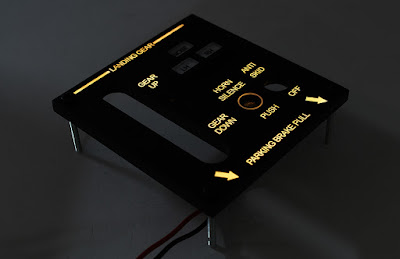As a continuation of the custom job previously documented here, the three panels shown below have all been designed to fit specifically dimensioned holes in an existing build, with our customer providing us good measurements and sketches of what he required. As a result of this, some artistic license has necessarily been applied here and there, although a good balance between authenticity and compromise has always been striven for - and hopefully achieved ...
________________________
The Doors Panel
The TCAS Unit
For some idea of what's involved in the design process, specifically relating to the placement of text and components on any given panel, the following image
was the basis for the above TCAS unit.
As you can see, the shape of these two panels are very different - the original (above) is not very high, whereas the space required to fill in our customer's simulator (below) is - and so a lot of time was spent on trying to get the proportions right.
Below is the end result ...
| ________________________ |
The Wx Panel
An important part of designing any new panel also includes trying to replicate, where possible, knobs and buttons that also reflect those used on real aircraft parts of course. The above buttons and dual encoder knobs are an example of this.
This Weather Panel is actually going to be interfaced with our boards and so the buttons, which are backlit, have been fitted onto the rear of the panel by way of vero board. This might not look very pretty (hence no photograph from the rear!) but it's more than likely a once-off design and it'll work fine. It also means that once again there's no need for an additional backing plate - the components are already fitted.
Again, the screen capture shown below (along with the dimensions
provided to us by our customer) provided the basis for our design,
which is here ...



















































